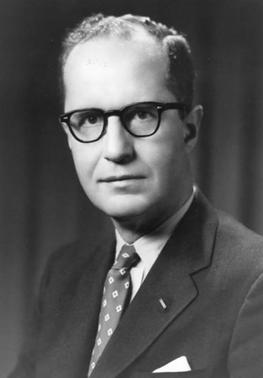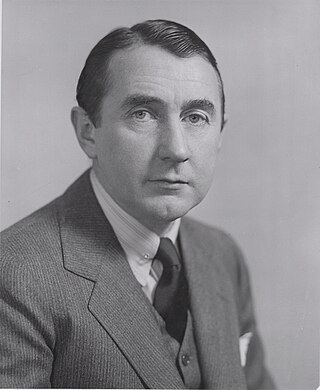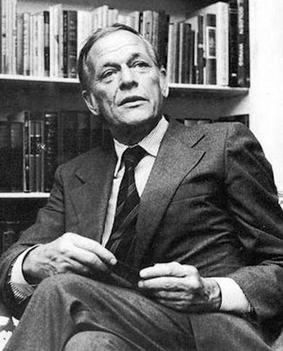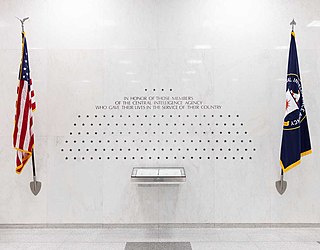
The Office of Strategic Services (OSS) was an intelligence agency of the United States during World War II. The OSS was formed as an agency of the Joint Chiefs of Staff (JCS) to coordinate espionage activities behind enemy lines for all branches of the United States Armed Forces. Other OSS functions included the use of propaganda, subversion, and post-war planning.

Allen Welsh Dulles was an American lawyer who was the first civilian Director of Central Intelligence (DCI), and its longest serving director. As head of the Central Intelligence Agency (CIA) during the early Cold War, he oversaw the 1953 Iranian coup d'état, the 1954 Guatemalan coup d'état, the Lockheed U-2 aircraft program, the Project MKUltra mind control program, and the Bay of Pigs Invasion in 1961. As a result of the failed invasion of Cuba, Dulles was fired by President John F. Kennedy.

William Joseph "Wild Bill" Donovan was an American soldier, lawyer, intelligence officer and diplomat. He is best known for serving as the head of the Office of Strategic Services (OSS), the precursor to the Bureau of Intelligence and Research and the Central Intelligence Agency (CIA), during World War II. He is regarded as the founding father of the CIA, and a statue of him stands in the lobby of the CIA headquarters building in Langley, Virginia.

Kermit "Kim" Roosevelt Jr. was an American intelligence officer who served in the Office of Strategic Services during and following World War II. A grandson of Theodore Roosevelt, the 26th President of the United States, Roosevelt went on to establish American Friends of the Middle East and then played a lead role in the CIA's efforts to overthrow Mohammad Mosaddegh, the democratically elected Majlis-appointed prime minister of Iran, in August 1953.

General Walter Bedell "Beetle" Smith was a senior officer of the United States Army who served as General Dwight D. Eisenhower's chief of staff at Allied Forces Headquarters (AFHQ) during the Tunisia Campaign and the Allied invasion of Italy in 1943, during World War II. He was Eisenhower's chief of staff at the Supreme Headquarters Allied Expeditionary Force (SHAEF) in the campaign in Western Europe from 1944 to 1945.

William Harding Jackson was a U.S. civilian administrator, New York lawyer, and investment banker who served as Deputy Director of the Central Intelligence Agency. Jackson also served briefly under President Dwight D. Eisenhower as Acting United States National Security Advisor from 1956 to 1957.
The Office of Policy Coordination (OPC) was the covert operation wing of the United States Central Intelligence Agency (CIA). Created as a department of the CIA in 1948, it actually operated independently until October 1950. OPC existed until 1 August 1952, when it was merged with the Office of Special Operations (OSO) to form the Directorate of Plans (DDP).

The Directorate of Operations (DO), less formally called the Clandestine Service, is a component of the US Central Intelligence Agency. It was known as the Directorate of Plans from 1951 to 1973; as the Directorate of Operations from 1973 to 2004; and as the National Clandestine Service (NCS) from 2004 to 2015.

Operation Sunrise was a series of World War II secret negotiations from February to May 1945 between representatives of Nazi Germany and the United States to arrange a local surrender of German forces in northern Italy. Most of the meetings took place in the vicinity of Bern, Switzerland, and the lead negotiators were Waffen-SS General Karl Wolff and American OSS agent Allen Dulles. The meetings provoked Soviet suspicion that the Americans were seeking to sign a separate peace with the Germans and led to heated correspondence between Joseph Stalin and Franklin D. Roosevelt, an early episode of the emerging Cold War.
Desmond FitzGerald was an American intelligence officer for the Central Intelligence Agency (CIA), where he rose to the position of Deputy Director of Plans. He served in the CIA from 1950 until his death. Posthumously he was awarded the National Security Medal. An attorney, he had worked in New York City both before and after World War II. During the war, he was an Army officer, serving as liaison and adviser to the Chinese Army.

Richard Mervin Bissell Jr. was an American Central Intelligence Agency officer responsible for major projects such as the U-2 spy plane and the Bay of Pigs Invasion. He is seen as one of the most important spymasters in CIA history.

Thomas Wardell Braden was an American CIA official, journalist–– best remembered as the author of Eight Is Enough, which spawned a television program–– and co-host of the CNN show Crossfire.
Thomas Hercules Karamessines was the Deputy Director for Plans of the United States Central Intelligence Agency from July 31, 1967 until February 27, 1973. Karamessines was actively involved in the Agency's Project FUBELT to undermine the government of Chilean president Salvador Allende.
Executive oversight of United States covert operations has been carried out by a series of sub-committees of the National Security Council (NSC).
At various times, under its own initiative or in accordance with directives from the President of the United States or the National Security Council staff, the Central Intelligence Agency (CIA) has attempted to influence public opinion both in the United States and abroad.
The Dulles–Jackson–Correa Report was one of the most influential evaluations of the functioning of the United States Intelligence Community, and in particular, the Central Intelligence Agency (CIA). The report focused primarily on the coordination and organization of the CIA and offered suggestions that refined the US intelligence effort in the early stages of the Cold War.
Henry Jindrich Strasak was an American Federal Bureau of Investigation (FBI) and Central Intelligence Agency (CIA) officer.
At various times since the creation of the Central Intelligence Agency, the Federal government of the United States has produced comprehensive reports on CIA actions that marked historical watersheds in how CIA went about trying to fulfill its vague charter purposes from 1947. These reports were the result of internal or presidential studies, external investigations by congressional committees or other arms of the Federal government of the United States, or even the simple releases and declassification of large quantities of documents by the CIA.
Carmel Offie was a U.S. State Department and later a Central Intelligence Agency (CIA) official, who served as an indispensable assistant to a series of senior officials while combining his official duties with an ability to skirt regulations for his and others' personal benefit. He has been described as "being as close to openly gay as was permissible in 1930s American officialdom". He was dismissed from the CIA in 1950 after an arrest a few years earlier brought his homosexuality to the attention of Senator Joseph McCarthy during the Lavender scare that saw a purge of the State Department personnel because of charges of homosexuality.

The United States Central Intelligence Agency (CIA) dates from September 18, 1947, when President Harry S. Truman signed the National Security Act of 1947 into law. A major impetus that has been cited over the years for the creation of the CIA was the unforeseen attack on Pearl Harbor, but whatever Pearl Harbor's role, at the close of World War II government circles identified a need for a group to coordinate government intelligence efforts, and the Federal Bureau of Investigation (FBI), the State Department, the War Department, and even the Post Office were all jockeying for that new power.












